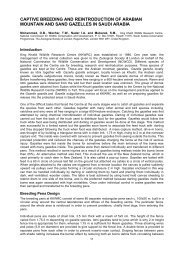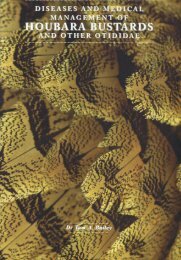His Highness Sheikh Zayed bin Sultan Al Nahyan - Wildlife Middle ...
His Highness Sheikh Zayed bin Sultan Al Nahyan - Wildlife Middle ...
His Highness Sheikh Zayed bin Sultan Al Nahyan - Wildlife Middle ...
Create successful ePaper yourself
Turn your PDF publications into a flip-book with our unique Google optimized e-Paper software.
Editorial<br />
This issue celebrates the tenth anniversary of<br />
the Falco newsletter. We are ten years old! The first Falco<br />
was produced in summer 1994 by Jaime Samour for the<br />
<strong>Middle</strong> East Falcon Research Group (MEFRG) – a brainchild,<br />
as the editor has put it, of Nick and Barbro Fox. The group’s<br />
original purpose was to link up Veterinary Surgeons,<br />
Biologists and Conservationists working in the <strong>Middle</strong> East<br />
and Central Asia regions. The Group intended to bring<br />
together the expertise already in existence in these different<br />
countries and to enlist valuable support from experts from<br />
around the world in subjects related to falcons and falconry.<br />
Now, looking back over the past decade, it is possible to<br />
conclude that the initial goal has been achieved with success.<br />
Above all, the MEFRG has organised 2 International<br />
Conferences on the conservation of the Saker Falcon and<br />
Houbara Bustard and has published proceedings.<br />
In May 2004 members of the MEFRG participated<br />
in the CITES meeting on the Saker falcon. The meeting was<br />
hosted by the Environmental Research and <strong>Wildlife</strong><br />
Deverlopment Agency (ERWDA), the scientific authority of<br />
CITES-UAE. Proceedings of the meeting one can beseen at<br />
the CITES web site (www.cites.org/.eng/prog/falcon.htm).<br />
One of the recent highlights of the MEFRG work is<br />
the web site www.savethesaker.org – an information portal,<br />
which contains all up-to-date information on the research and<br />
conservation of the Saker falcon. The MEFRG is a nonsubscription<br />
body and we cannot afford to circulate Falco in<br />
hard copy to everybody. But now Falco is available online<br />
and is freely available to all thanks to hard work by Eugene<br />
Potapov.<br />
It was Nigel Barton who suggested the name<br />
“Falco” for the newsletter. In the early days Jaime and Merle<br />
Samour used to spend the evenings at NARC wearing out the<br />
photocopier into the early hours of the morning, now the<br />
newsletter is produced in Wales and is a full colour ISSN<br />
registered periodical.<br />
The houbara bustard programme of the National<br />
Avian Research Center has come a long way over the past<br />
decade and this season the project bred more houbara bustard<br />
chicks than ever. These 200+ chicks represent a great<br />
landmark for the project. It is to be hoped that the success of<br />
NARC may act as a regional catalyst, promoting the<br />
establishment of more houbara projects in the Gulf.<br />
Congratulations to the persistence of HE Mohammed al<br />
Bowardi and NARC for the hard work over the past decade.<br />
The ability of captive breeding projects to produce birds that<br />
can be used to train falcons locally is a step in the direction of<br />
reducing the illegal importation of wild-caught houbara<br />
bustards into the region. Just as 10 years ago visitors to falcon<br />
hospitals would have seen mostly wild-caught falcons, the<br />
proliferation and success of regional, North American and<br />
the visitor to a falcon hospital sees almost exclusively captive<br />
bred falcons. In the same manner, perhaps the next decade<br />
will see the widespread availability of captive bred houbara<br />
bustards for falconers.<br />
At the same time we are concerned to ensure that<br />
captive-breeding is not percieved as the total solution. Efforts<br />
to conserve wild populations of falcons and houbara must be<br />
stepped up. Systems need to be developed that conserve wild<br />
populations in accordance with CITES criteria for sustainable<br />
use.<br />
The year 2004 has bought new developments to the<br />
falcon health scene in the <strong>Middle</strong> East. A new falcon hospital<br />
is shortly opening at Nad al Shiba in Dubai under the<br />
guidance of Chris Lloyd, while Peter McKinney has moved<br />
into a new facility, also in Dubai. Antonio Di Somma from<br />
Dubai Falcon Hospital has been conducting clinical trials on<br />
the new antifungal drug voriconazole which has made a<br />
positive impact in the treatment of aspergillosis. The flip side<br />
of finding a better drug to treat aspergillosis has been hearing<br />
reports of the widespread mis-use of this medicine by nonveterinarians<br />
as an aspergillosis prophylaxis. It will not be<br />
long before birds arriving at falcon hospitals with<br />
aspergillosis will be unresponsive to voriconazole. Dr<br />
Miriam Hampel operating from the Central Veterinary<br />
Research Laboratory, (CVRL) has completed an in-depth<br />
investigation into falcon amyloidosis, an emerging falcon<br />
disease, and we look forward to reporting her findings once<br />
her dissertation is written up. Congratulations are also in<br />
order for the CVRL team and Jaime Samour who have<br />
produced a new book on falcon medicine.<br />
The Arab Hunting Exhibition has become a feature<br />
of the start of the falconry season in the <strong>Middle</strong> East. To<br />
quote H.H. Sh. Hamdan <strong>bin</strong> <strong>Zayed</strong> al <strong>Nahyan</strong>, Chairman of<br />
the Emirates Falconers Club – “the sport of falconry has<br />
played an essential part in the culture and legacy of the<br />
Arabian peninsula and stands as a testimony to the strong<br />
bond of this region with nature, its love and commitment to<br />
sustainable wildlife utilisation and conservation.” In other<br />
parts of the world field sports are coming under pressure from<br />
urban anti-hunting groups. Because of the relationship<br />
between man and bird, falconry is different from other ‘field’<br />
sports. At its best, falconry is a sport that connects the<br />
falconer with the falcon and the environment. As long as<br />
falconry opens people’s eyes to the wonder of the natural<br />
world and fosters a caring attitude to the environment then it<br />
will deserve to continue. Those in positions of authority and<br />
leadership in the falconry world have a special responsibility<br />
to promote responsible falconry practices, for if they do not,<br />
future generations will not be able to enjoy this special<br />
pastime.<br />
The newly-formed Emirates Falconers’ Club was<br />
accepted into the International Association of Falconry last<br />
year. This year the EFC hosted all the delegates of the IAF for<br />
their Annual General Meeting. This was a chance for<br />
falconers from many other countries to visit and gain a deeper<br />
insight into Arab falconry and have a good exchange of views<br />
and information. Gradually communication links are<br />
improving for the Arab falconer, and with improved<br />
communications, such as <strong>Al</strong> Saggar, the journal of the EFC,<br />
comes a better understanding of the issues faced by falconry.<br />
This is the way forward for a sustainable future.<br />
So, ten years on, falconers, veterinarians and<br />
biologists have a forum for a frank exchange of views<br />
and information on Arab falconry issues. Falco has<br />
stayed the course and is here as a service to you – feel<br />
free to use it!<br />
European falcon captive breeding projects means that today 2




